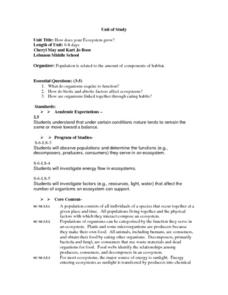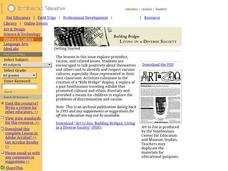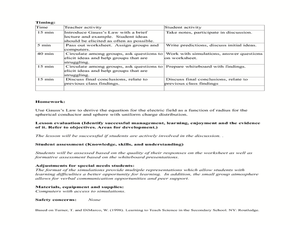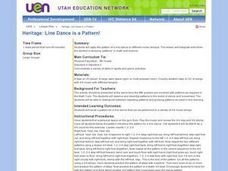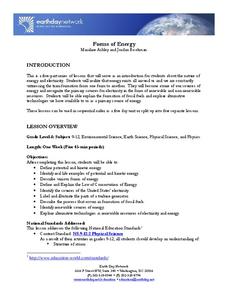Curated OER
Systems of the Body: Movement and Choreography
Young scholars create movements that connect art and science. In this body systems lesson, students interpret the function of body systems, organs, and processes as they create movements to exhibit their research findings.
Curated OER
How Does Your Ecosystem Grow?
Students consider that under certain conditions in nature tend to remain the same or move toward a balance. They observe populations and determine the functions (e.g., de-composers, producers, consumers) they serve in an ecosystem. They...
Curated OER
Submersible Designer
Students work in groups to design, build, and test a submersible prototype. In this engineering lesson, students learn about the importance and design of submersible vessels and apply their knowledge by building one of their own. They...
Curated OER
Electric Charge
Students discover and identify positive and negative electrical charges and understand that like repels and opposite charges attract. In this physics lesson, students observe how friction can be used to give electrical charge to various...
Curated OER
Introduction to the Periodic Table of Elements
Learners explain how the elements are arranged in the periodic table. In this chemistry instructional activity, students determine the subatomic particles for certain elements. They research the physical and chemical properties of an...
Curated OER
Magnifiers
Students describe how several different objects magnify a provided sentence and decide if they are good magnifiers or not. They then write a sentence describing two properties an object must have in order to be a good magnifier.
Curated OER
Chemical Changes
Eighth graders observe two types of interactions in a sealed plastic bag. One bag contains baking soda and water, and the other baking soda and vinegar. They determine what evidence indicates that a chemical change is occurring.
Curated OER
Building Bridges: Living in a Diverse Society
Students participate in various activities that help them build esteem, and explore racism. In this multicultural lesson plan, Students increase their awareness of, and appreciation for, cultural differences and similarities. This...
Curated OER
Badminton
Students evaluate their partner in playing a game of badminton. In this badminton lesson plan, 8th graders explain the rules of the game and participate in a warm up. Additionally, students observe their partners by completing a...
Curated OER
How Do Foods Help Our Bodies
Students investigate the specific elements found in food that keep us healthy. In this healthy eating lesson, students identify proteins, carbohydrates, minerals, and vitamins as part of a healthy diet when consumed in moderation....
Curated OER
Gauss' Law
Learners derive the equation of Gauss's law. In this physics instructional activity, students investigate the factors affecting the strength of the electric field. They perform simulation on Gauss's law.
Curated OER
Gravity - What is It?
There is scant information on these slides: definitions of gravity and force, and the fact that objects fall at the same speed. Two slides give learners an activity to try to demonstrate aspects of gravity. Although the activities are...
Curated OER
Leaves
Pupils engage in a lesson plan which gives them a better understanding of how the water system of a plant works. They make leaves that demonstrate how the water moves through them. Students use coffee filters, water and food coloring to...
Curated OER
Heritage: Line Dance is a Pattern!
Line dancing is the repeating of a pattern of steps, done to music. Teach youngsters how to line dance and they won't feel so awkward when they grow up. Let them experiment with creating their own patterns and teaching their classmates....
Virginia Department of Education
Hurricanes: An Environmental Concern
Hurricanes, typhoons, and tropical cyclones are the same type of storm, but their names change based on where they happen. Scholars use a computer simulation to learn about hurricanes. Then they hypothesize ideas to prevent hurricanes...
Earth Day Network
Forms of Energy
Give me a home where electric buffalo roam and I'll show you an ohm on the range. Introduction your classes to potential and kinetic energy, electricity, and renewable resources with a resource that combines observation, direct...
Intel
Lights, Camera, Reaction!
Excite classes with a STEM project-based learning lesson covering chemical reactions. Groups study the different types through simulations and hands-on activities. They pick one type (synthesis, decomposition, single displacement, double...
NOAA
Biological Oceanographic Investigations – Through Robot Eyes
How can a robot measure the length of something when we don't know how far the camera is from the object? The lesson explains the concept of perspective and many others. Scholars apply this knowledge to judge the length of fish and the...
Lerner Publishing
Living or Nonliving
It's alive! Or is it? Through a series of shared readings, whole class activities, and independent exercises children explore the difference between living and non-living things, creating a pair of printable books to demonstrate their...
Cornell University
Building Spectroscope
Given specific materials, scholars follow a set of instructions to build and calibrate their very own spectroscopes. After construction, they test the scope for accuracy and make modifications where necessary.
Curated OER
Teacher Appreciation Week (Elementary)
Primary writers will create a persuasive essay about Teacher Appreciation Week. Additionally, they will select a quote from a famous person and write a persuasive essay about how it relates to one of their favorite teachers. In the end,...
Curated OER
Community Helpers
Community Helpers are the focus of this sociology activity. Learners brainstorm the many different jobs done in their community, discuss why they are necessary, and think of ways they can be community helpers.
University of Minnesota
Neurotransmission Model
Don't lose your marbles — you'll need them for a lesson on neurotransmission. Young scholars build a neurotransmission model using marbles, beads, rubber bands, string, and other elements. After studying specific neurotransmitters,...
Baylor College
Heart and Circulation: Pre- and Post-Assessments
Middle schoolers demonstrate what they know about the structure and function of the heart and blood vessels. A set of 15 multiple-choice questions also addresses how the heart handles microgravity and how animals without circulatory...



